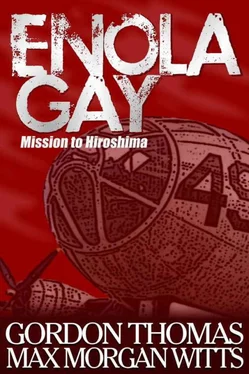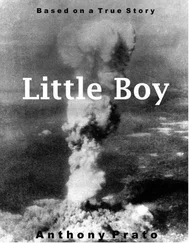Finally Tibbets turned to the present. “Tom, we are going to need good men for this job. If it works, we’ll flatten everything within eight miles of the aiming point.”
Ferebee considered what he should say. “That’s quite a bang, Paul.”
The bombardier made no other comment. Restraint was one of Ferebee’s qualities. He was always prepared to wait and to listen. His friends said the only time he really asserted himself was in combat, at the poker table, or when a pretty girl passed.
Tibbets asked him if he could recommend anybody they should bring in for “the job.”
“What about ‘Dutch’?”
Theodore “Dutch” van Kirk had been their navigator in Europe. Quietly professional in the air, he and Ferebee had caroused and gambled off-duty. Occasionally Tibbets had joined them in their whoopee making, smiling indulgently as his younger companions staged their own blitzkrieg on London’s nightlife. Ferebee explained that van Kirk was back in America, had married, and was now based in Louisiana. Tibbets said he would have the navigator transferred to Wendover. Van Kirk could raise the standards of the 393rd’s navigators to that required for an atomic strike mission.
“Tom, I want every one of these crews to be lead crews, capable of finding their way to a target without having pathfinders up front leading the way and dropping marker bombs.”
Ferebee had two further suggestions for men who could meet Tibbets’s requirements. One was a bombardier, Kermit Beahan; the other was a navigator, James van Pelt. Both had previously impressed Ferebee.
Tibbets said they would be recruited. He announced his own choices. They were all men who had served with him on the B-29 testing program. Three of them were pilots: Robert Lewis, Charles Sweeney, and Don Albury.
Lewis, Tibbets explained, was a little wild, but a natural pilot; Sweeney was Boston Irish “and would fly a B-29 through the Grand Canyon if you asked him”; Albury “was about the most competent twenty-five-year-old I have ever known.”
He had one other selection, Staff Sergeant Wyatt Duzenbury, his former flight engineer. “Tom, Dooz can coax magic out of airplane engines, and he’s a helluva guy when you’re in a corner. Give him an engine fire and he becomes steady as a rock. Give him two and he becomes even steadier.”
By the end of the evening, Tibbets and Ferebee had virtually decided on the men who would fly the first atomic strike.
Lieutenant Commander Mochitsura Hashimoto of the Imperial Japanese Navy had ordered a trim dive for 1700 hours on September 17. Submarine I.58 was to dive three hundred feet below the waves of Hiroshima Bay to test the watertightness of all hull valves and openings.
I.58 had been commissioned at Kure four days earlier; this was the first time she would be submerged. From the day he had first seen her, back in May, Hashimoto had been impressed by the boat; she was one of the I -class submarines, larger and faster and better equipped than almost any boat of a comparable class anywhere in the world. Two diesel engines gave I.58 a cruising speed of 14 knots; submerged, her motors drove the submarine at 7 knots. With a range of 15,000 miles, she could remain at sea for three months. For her six torpedo tubes, all forward, she carried nineteen torpedoes, the most advanced in the world. Oxygen-fueled, leaving no wake, they had a speed of 58 knots and a range of 5,500 meters. Each 2-foot-diameter torpedo carried a 1,210-pound explosive charge.
Today, for the hull tests, the torpedo room was empty, except for the rats that infested the submarine. Every effort to exterminate the rodents had been unsuccessful. But they were the only problem that Lieutenant Commander Hashimoto had failed to overcome. His endless battles with the Kure Naval Dockyard, the Naval Technical Department, and the Naval Research Bureau had paid off. I.58 was equipped exactly the way he wished.
Standing on the boat’s bridge, as it moved through the water a little over a mile south of Hiroshima, Hashimoto looked through his binoculars at the naval academy on the island of Etajima. Nothing seemed to have changed since he had been a cadet there from 1927 to 1931. Three years later, in 1934, he had been assigned to submarines; he had loved the life. But a spell of duty in destroyers and subchasers, operating in the waters off China, had intervened. It was not until 1938 that he was selected to be a full-time member of the submarine service. By then he was married, and in 1940 his wife gave birth to their first child, a son.
Professionally, Hashimoto had found himself caught up in events which stirred him deeply. He was assigned to the naval task force supporting the air attack on Pearl Harbor, a torpedo officer on one of the five submarines which had each launched a two-man midget submarine against the American fleet. The midget subs had failed in their mission; all were sunk. But Hashimoto’s own craft had made good its escape. Since then, he had enjoyed an unspectacular war.
He liked it that way. The first time he had assembled the crew of I.58 , he told them he was expecting competence, not “senseless heroics.”
Hashimoto had personally selected many of his 105 officers and men. Some of them had been with him on his previous submarine. They thought their thirty-five-year-old captain firm but fair. He was widely experienced and had a reputation for surviving.
A few of the newcomers were young; Hashimoto looked upon this as another sign that the war was demanding a supreme effort. But, like the others, his youngsters were eager and shaping up well.
I.58 reached its diving station.
Hashimoto climbed down from the bridge to the control room. He watched and listened to the final preparations for diving; the air was filled with quiet orders, reports, the sounds of bell signals.
The main engines were clutched out; the electric motors began to run at full whine. The outboard exhaust and air-induction valves were closed off.
The engine room informed the control room that it was ready to dive. The lookouts came below. The officer of the watch spun the handwheel which clamped the flanged lid leading to the conning tower against its seating. The seamen at the ballast tank vent levers reported that all the main vents were clear. The chief turned to Hashimoto and reported that the boat was ready to dive.
Hashimoto gave the order. “Dive! Dive! Dive! Thirty feet.”
He watched as the sailors opened the main vent levers. A roar of air escaped from the main ballast tanks. I.58 was no longer buoyant. The depth gauge began to move, slowly at first, then with gathering speed. Outside, the sea could be heard slapping against the conning tower. Then the sound died. The bridge was beneath the waves. The electric motors took over.
The chief reported that the boat was properly trimmed.
Hashimoto ordered the main vents shut. I.58 continued to drop through the water. Suddenly, a vibration ran through the boat. The chief ordered the submarine to be retrimmed. At one hundred feet, I.58 was suspended on an even keel, held in place by the careful balance of water in the compensating and trimming tanks.
Leakage points and discharge-pump capacities were once more tested. There were no defects.
Hashimoto ordered I.58 to be taken deeper. The trouble came suddenly, and with a gush of water at two hundred feet.
A leak had developed in the torpedo room. The area was at once sealed off.
Hashimoto gave his orders quickly, with no sign of concern, aware now of the anxious faces around him.
I.58 steadied and then began to climb rapidly toward the surface. There, the diesel motors took over.
Читать дальше












